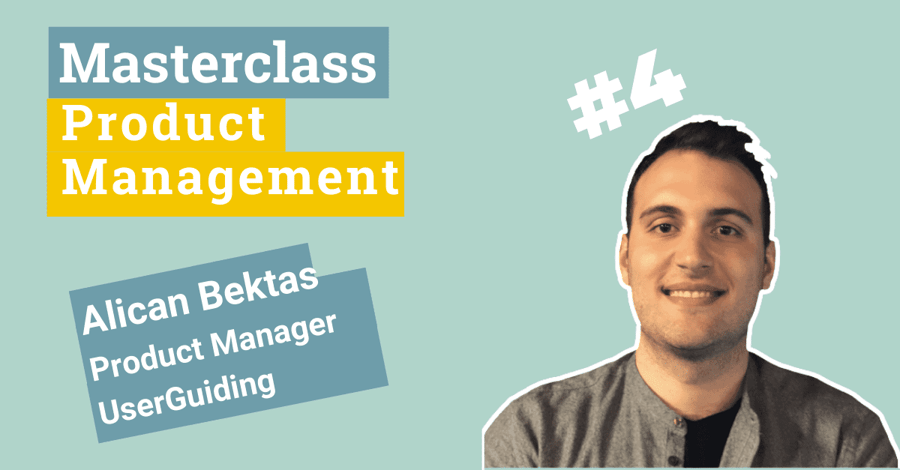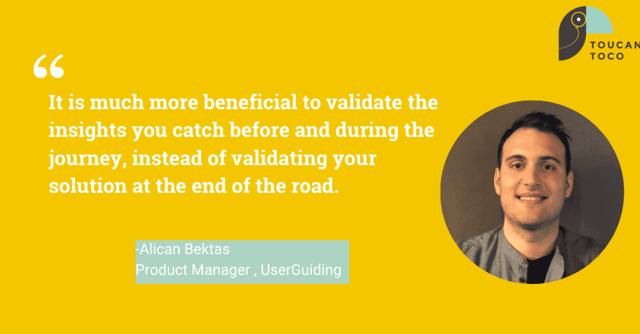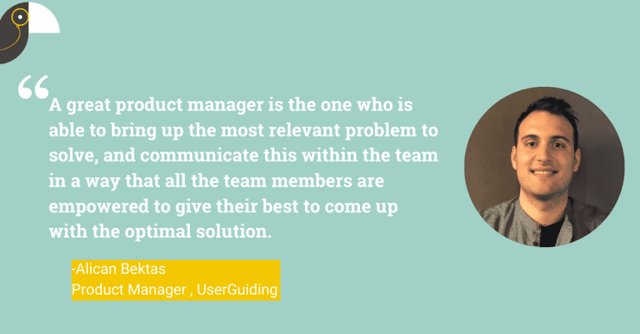
1. Tell us a bit about yourself!
My name is Alican and I am the 3rd member of the UserGuiding Team. I am a huge fan of team sports and coaching a college football team here in Turkey.
I have a hearty appetite and love tasting different kinds of food from all around the world, without doubt Turkish Cuisine is my favourite 🙂
I also enjoy talking about visual arts and travel destinations.
You can always contact me via linkedin.
2. In one word or one sentence, how would you describe your product management style?
I seek opportunities.
3. How did you get into product management?
I am a self taught product person, for me this role has emerged naturally from our need of exploring what to build and what not to build. Before that, I was the product designer and I was also attending the demo and support calls at the same time. As we all know, everyone has more than just one role in early stage start-ups. All these calls and conversations left me with lots of feature requests and needs that have been discovered. We had to respond to all of these in the most efficient way with our limited resources, and this is how my current role came about.
4. What are one or two things you typically do during the first hour of your day that lead to a productive day?
Just like everyone else, I wake up and then check my calendar to plan my day. Then, I have a look at the Customer Support conversations of the previous 24 hours. The questions or issues that our customers have always shed a light on the frictions that we should be focusing on next. Right after that, I meet with my teammates to start our daily stand-up.
5. How would you explain Product Management to a 5-year-old?
I listen to people to understand what their dream toy is like. Then we gather up with my friends, I share what I’ve learned and we work hard to make these dreams come true.
6. What are some of the qualities of great product managers?
In my opinion elite product managers are the ones that enable their team members to achieve their full potential. With the help of their team members, great product managers are able to set a vision that will enable all stakeholders to make better decisions and keep them aligned around the same objective.
Another great skill and a serious challenge is to be able to make the team own the problems of the users. Designers and developers are heavily skilled at solving the problems, a great product manager is the one who is able to bring up the most relevant problem to solve, and communicate this within the team in a way that all the team members are empowered to give their best to come up with the optimal solution.
And the last trait I would like to mention is being accessible, especially for the early stage product teams where everyone has multiple roles and challenges to overcome. Any problem can be solved with effective and open communication. So this principle applies not only to the product managers but all the members within the team.
7.How can PMs stay ahead of user requirements or make sure they’re aware of them early?
Talking to your user base on a regular basis is a great way to accomplish this. Our roadmap and the actions we are planning to take are heavily dependent on the interviews that we have with our customers. Even if it is a B2B solution, your users are real people that have needs and requirements, which aim to make both themselves and their business more successful.
We also work on a concept which we call ‘early validation’. The main idea behind this concept is that it is never early to make validations for your moves. You do not need to prepare a prototype to validate your possible solutions, you can also validate your PRD’s / One Pagers or the insights that you collect by using the right techniques just before you dive deep into the solution space.
Alignment with other departments is also an important topic. Especially the Sales and Customer Success People within our company really help us clarify what is on the horizon.
8. How do you know if a product is well-designed?
I am sure there are lots of people out there who believe that Good Design is a subjective concept. But if we are talking about products that aim to make life easier for us, this is not the case.
In my opinion, a well-designed product is the one that can successfully communicate the value it can bring to you, from the very first moment. A good design can shorten the path that leads to the value, or remove the obstacles on the way. You can easily tell if the product that you are using is a well-designed one, when your progress is visible and you keep getting closer to your goals.
I think we have successfully adopted this approach with our team, since day 1. We always put the value first and then create the most efficient journey to obtain it.
9. What is one best practice you’ve adopted/applied in the last few months that had a positive impact on your role? How has it helped you?
There is actually this new thing that we have adopted as a team, which had a high positive impact on our retrospective ceremonies.
Every 2 weeks we hold a retrospective meeting with our PMs and Designers. At the end of these meetings, we choose an image that reflects our mood and how we feel about the work that we have produced within this 2 week period. This could be an image of a statue, a landscape, sports moments or sky, whatever we believe that will help us remember how we felt about this period of time, in the future. After we choose the image, we go back and have a look at the previous ones that we chose before and visualize our progress. This practice allows us to remember the positive or negative moments in the past along with the reasons and helps us remember the lessons we have learned.
10. WHAT ARE SOME COMMON MISTAKES YOU SEE PRODUCT TEAMS MAKING
I believe that there is a lot to discover for the validation practices. As product teams, our aim is to present the most valuable solution by utilizing a limited amount of time and effort. We have to make sure that the resources we spend will pay off and the outcome will be satisfying both for our company and our users.
To accomplish this, we should validate each step we are planning to take before getting into action. Most product teams, sometimes our team too, utilize the validation practices after they move into the solution space. So there is a huge gap of assumptions that are never being validated, between the discovery of the requirements and coming up with possible solutions.
In my opinion, it is much more beneficial to validate the insights you catch before and during the journey, instead of validating your solution at the end of the road. It may be too costly to find out the missing parts at the end of the process, rather than noticing them early and iterate accordingly, especially for the early stage product teams such a mistake could destroy motivation.
11. Any closing thoughts/things you’d like to add?
As product managers, we do tons of research all the time. We always look for what to build, how to build and mostly why to build, and each of us has our own unique set of product management practices.
There are some methods out there that people refer to as ‘the best practices’. We should always keep in mind that another organization’s best practices may not be the perfect fit for our team. Especially for early-stage product teams, I recommend that we learn all these best practices in detail and apply them one by one to find the best configuration. We should spend enough time to discuss and iterate how we build products as a team, and always keep in mind that each method we agree on is subject to change over time.



